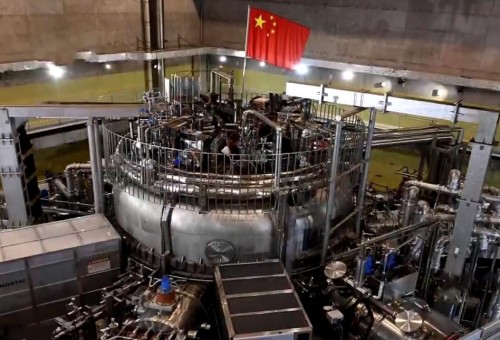The artificial star was maintained for 102 seconds before the 49.999 million degree Celsius mass melted the core of the nuclear fusion chamber.
The Experimental Advanced Superconducting Tokamak (East) project is part of global efforts in figuring out how to create a viable source of energy from nuclear fusion reactors, so as to provide a more efficient alternative to our current systems, which are heavily reliant on the use of fossil fuels.
The project, which cost 300 million yuan (approximately $37 million), is attempting to solve a fundamental problem that scientists have had since the Industrial Revolution; that of creating more energy from machines than the initial input.
Nuclear fusion works on heating a combination of two types of hydrogen gas - deuterium and tritium - to around 100 million degrees Celsius in order to create energy from the plasma that subsequently forms. This particular type of power has fascinated scientists since the early 1940s, and, with a planet rapidly depleting its fossil fuels, is increasingly being seen as best alternative power source for the future.
Fusion reactors, and the energy they produce, have many benefits compared to their fossil fuel-based counterparts; they are carbon free, produce no nuclear waste, and cannot constitute a safety hazard. Most importantly, they are extremely efficient: 1 kilogram of fuel produced in this manner is equivalent to 100 million kilograms of fossil fuels, according to the Culham Centre for Fusion Energy.
Monday’s experiment was a huge step forward in understanding how nuclear fusion works, as Chinese scientists were able to create an energy source for 102 seconds that was 49.999 million degrees Celsius.
For context, that is 8,600 times hotter than our planet’s core.
“The East project research results will be significant for the International Thermonuclear Experiment Reactor, in terms of basic research both in engineering technology and physics,” said Wan Yuanxi, the project head, in a press statement.
Soviet technology, Chinese intuition
Created in the 1950s by Soviet scientists Igor Tamm and Andrei Sakharov, a Tokamak (the “t” in “East” project) refers to a mass of plasma in the shape of a torus. To generate it, one needs a toroidal magnetic chamber; essentially a massive metallic doughnut-shaped chamber.
The principle behind it is using magnetic confinement fusion - one of the two main branches of nuclear fusion theory, apart from inertial confinement - to generate power via magnetic fields. Most attempts to create nuclear fusion follow these lines, as plasma’s natural electrical conductivity can be used to theoretically contain it with magnetic fields.
It does work; but currently no core has been created which can withstand such an awesome temperature for more than a few minutes.
So the challenge that faces the scientific community is how to sustain a temperature three times that of the core of the sun for long enough to be a viable source of power. And with our global deposits of fossil fuel rapidly dwindling away, it’s a problem that requires a solution soon.

Chinese scientists at the Institute of Physical Science in Hefei achieved something spectacular on Monday: the creation of a temporary artificial star three times hotter than the core of our sun.




